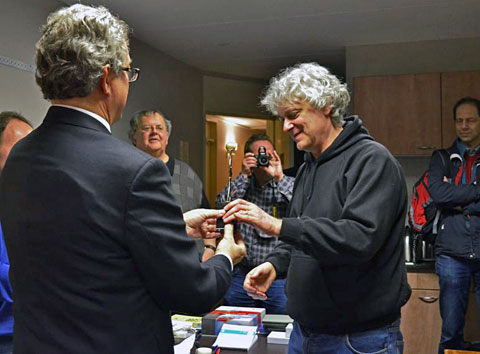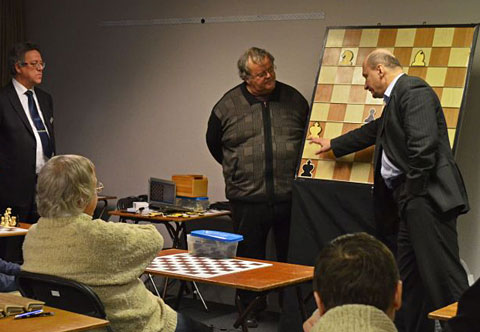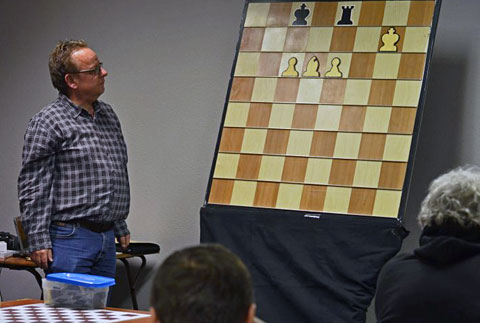Solving Competition solutions
One of the attractive features of the annual Tata Steel tournament is that it is not only about the top tournament. One is an event takes place in the hotel Zeeduin, a few minutes’ walk away from the tournament venue. Five years ago, study composer and enthusiast Yochanan Afek proposed having a study solving event at Wijk aan Zee on the final Saturday of the tournament. The idea was taken up, some modest prizes offered and since then the event has been repeated almost every year.

The opening of the Studies Solving Competition, with Jan Timman and his wife standing behind board one solver John Nunn. Jan contributed some very nice endgame compositions – he has a great passion for studies – but was playing in the Tata Steel tournament and could not compete in the Studies Solving.

I was on good form at Wijk, and won the event with 43 points out of the maximum of
45, the highest score achieved in all four years, using 2¼ out of the given three hours.
Nine studies of varying difficulty were provided and the solvers were given three hours to find all the solutions. In my previous report I gave a selection of three studies from the competition for readers to solve. To duplicate the conditions of the event you were to give yourself one hour to solve all three. Here now are the solutions.

[Event "The Problemist 2013"] [Site "?"] [Date "2013.02.05"] [Round "?"] [White "Krug, Peter"] [Black "White to play and win"] [Result "1-0"] [Annotator "Nunn,John"] [SetUp "1"] [FEN "3b1K2/3R4/5kp1/4N3/3N2Pq/2p5/8/5B2 w - - 0 1"] [PlyCount "13"] [EventDate "2013.??.??"] 1. Nf7 $1 {The only winning chance, since Black was threatening mate on h8 and the lines} (1. g5+ $2 Kxe5 2. Nf3+ Ke6 3. Nxh4 Kxd7 {and}) (1. Rf7+ Kxe5 2. Nf3+ Kd6 3. Nxh4 c2 {allow Black a comfortable draw}) 1... Be7+ {Forced, as otherwise Black cannot meet the lethal thrats of 2 Rd6+ and 2 g5+. By deflecting the rook to e7, Black nullifies the rook mate.} 2. Rxe7 (2. Ke8 $2 Qxg4 3. Nh6 Qe4 4. Ng8+ Kg5 5. Nxe7 c2 {leads to a draw.}) 2... Qxg4 { Capturing the pawn deals with White's other main threat. Although White has enough material to win, his pieces are badly co-ordinated, the c-pawn is dangerous and Black has the immediate threats of 3...Qxd4 and 3...Qc8+ 4 Re8 Qc5+.} 3. Bh3 $1 {This spectacular sacrifice is the start of an amazing winning combination. Black must accept, or else White plays 4 Re6+.} (3. Re6+ $2 Qxe6 4. Nxe6 c2 {is fine for Black.}) 3... Qxh3 4. Rc7 {Simultaneously stopping the check on c8 and threatening to mate by Rc6+. However, now that White has given up his bishop, Black only needs to give up his queen for the rook to draw (in the resulting 2N vs 2P ending, the advanced c-pawn gauarantees a draw).} Qh1 (4... Qg2 5. Ra7 Qf1 {transposes.}) 5. Ra7 $1 (5. Rd7 $2 Qa8+ 6. Rd8 Qxd8+ 7. Nxd8 {is only a draw.}) 5... Qf1 {The only way to cover a6, but now it looks like a dead end for White as if the rook moves along the seventh rank, Black plays ...Qa6. During the event, I reached this point quite quickly, but couldn't see any way to win and went back to look at some other lines. Only when I was convinced that there was no alternative did I return to this point and spot the winning idea.} 6. Ra2 $3 {Incredibly, this move puts Black in zugzwang. Although it isn't relevant to the solution of the study, if White were to play here he would be unable to win, so this is in fact a reciprocal zugzwang.} g5 {The queen cannot move as it must guard both a6 and f2, while} (6... c2 7. Rxc2 {leaves Black's queen with the impossible task of stopping the mates on c6 and f2.}) 7. Rh2 {Opening the sixth rank has created a fatal weakness, which White exploits by switching his rook to the other side of the king. Now White wins, as Black cannot prevent both 8 Rh6# and 8 Rf2# without giving up his queen for a knight by 7... Qf5. A great study which was also fun to solve.} 1-0

[Event "The Problemist 2013"] [Site "?"] [Date "2013.02.05"] [Round "?"] [White "Bates, Caspar"] [Black "White to play and win"] [Result "1-0"] [Annotator "Nunn,John"] [SetUp "1"] [FEN "1r3q1k/2N2P1p/6pQ/4p3/7p/n6P/3B4/7K w - - 0 1"] [PlyCount "39"] [EventDate "2013.??.??"] {Black is well ahead on material, so if White is even to draw then he must find something special. His only hope lies in the confined position of Black's king, so if he wants to win (or even draw) he must retain the f7-pawn.} 1. Qf4 $1 {A surprising first move kicks off a long and intricate solution. The winning line is so deep that even Houdini 3 on a 6-core machine has trouble seeing any advantage for White.} exf4 {Black may as well accept.} (1... h6 2. Qxh6+ Qxh6 3. Bxh6 {wins as the deadly 4 Ne8 is threatened, while}) (1... Nc4 { is refuted by} 2. Ne8 $1 {with a winning attack. Black can play}) (1... Qg7 { but after} 2. Bc3 exf4 {we transpose to the main line.}) 2. Bc3+ Qg7 3. Ne8 { The threatened mates on g7 and f8 cannot be met directly, so Black is obliged to start checking.} Rb1+ {The study revolves around White's attempts to avoid the checks from Black's rook.} 4. Kh2 $1 {Care is already necessary, since after} (4. Kg2 $2 f3+ 5. Kf2 Rb2+ 6. Kf1 Rb1+ {White cannot escape from the checks without allowing Black to take the bishop with check.}) 4... Rb2+ 5. Kg1 Rb1+ 6. Kf2 Rb2+ 7. Kf1 {Not to e1, of course.} Rb1+ 8. Ke2 Rb2+ {This forces White to play accurately. It's an easier win after} (8... f3+ {since} 9. Kd3 Rd1+ 10. Ke4 Re1+ 11. Kf4 g5+ 12. Kf5 {leaves Black without a decent check.}) 9. Kd3 Rd2+ $1 {Black defends ingeniously, hoping for 10 Kxd2 Nb1+ and Black will be able to take the bishop with check.} 10. Ke4 {Having moved across the board, the king now moves towards the eighth rank.} Re2+ 11. Kd5 Rd2+ 12. Ke6 Re2+ 13. Kd7 {For the moment the f-pawn is pinned, but this doesn't actually help Black.} Rd2+ 14. Ke7 $1 {Avoiding the trap} (14. Nd6 $4 Nc4 {and Black wins since White cannot promote the f-pawn.}) 14... Re2+ 15. Kd8 Rd2+ 16. Nd6 $1 {With the f-pawn free to move, White is threatening mate in one and so Black has no time to bring his knight into play.} Rxd6+ 17. Ke7 {The knight sacrifice has drawn the rook close to the white king, so there are no safe checks} Rd7+ 18. Kxd7 Nb5 19. Bxg7+ Kxg7 20. Ke7 {and White finally wins.} 1-0

[Event "The Problemist 2013"] [Site "?"] [Date "2013.02.05"] [Round "?"] [White "Timman, Jan"] [Black "White to play and win"] [Result "1-0"] [Annotator "Nunn,John"] [SetUp "1"] [FEN "2n3k1/p5p1/3p1pPP/1PpP1p2/2p2P2/1bP5/2R1P2r/R4K2 w - - 0 1"] [PlyCount "20"] [EventDate "2013.??.??"] {The position is not very attractive, with its thick clusters of pawns, but in compensation the famous Dutch grandmaster has conjured up a remarkable winning idea.} 1. h7+ {An obvious first move, forcing the black king into the corner and setting up a possible back-rank mate.} Kh8 2. Rxa7 $1 {The first hammer-blow, freeing the b-pawn to advance. Black must accept or White's rook reaches the back rank.} (2. Rcc1 $2 Rh1+ 3. Kf2 Rxc1 4. Rxc1 Ba4 $1 5. Rb1 Ne7 6. b6 axb6 7. Rxb6 Nxg6 8. Ke3 Kxh7 9. Rxd6 Ne7 {is insufficient, since Black is certainly not in danger of losing.}) 2... Nxa7 (2... Rh1+ 3. Kf2 Nxa7 4. Ra2 $1 {transposes}) 3. Ra2 $3 {The first rook sacrifice is surprising, but the second is astonishing. The idea is partly to block the a-file, but there is more to it than that.} (3. b6 $2 Bxc2 {fails because Black can switch his rook behind the pawn by ...Rh1+.}) 3... Bxa2 4. b6 {At first sight it's the end of the road, since 4...Nc8 loses to 5 b7, but Black has a cunning defence.} Rh1+ 5. Kf2 $1 (5. Kg2 $2 {is tempting, but Black can defend by} Bb1 6. Kxh1 {or else ...Be4+ followed by playing the rook behind the pawn} Be4+ 7. Kg1 Nc6 8. dxc6 Bxc6 {with a draw, as White cannot penetrate with his king; for example,} 9. Kf1 d5 10. e3 Bb7 11. Ke2 Bc6 12. Kd2 Bb7 13. Kc2 Bc6 14. Kb2 Bb7 15. Ka3 Bc6) 5... Ra1 {This is Black's idea; he stops the pawn after 6 b7 Rb1, while after 6 bxa7 he just moves the bishop. Given Black's huge material advantage, it looks all over for White.} 6. Ke3 $1 {This move puts Black is in an amazing zugzwang. Other moves fail; for example,} (6. e3 $4 Bb1 7. b7 Ra2+ { and ...Rb2, or}) (6. Kg3 $4 Rc1 {followed by ...Rxc3+}) 6... Rc1 {The only move, as otherwise the b-pawn runs through (6...Bb1/b3 7 b7 or 6...Nc8 7 b7).} 7. Kd2 Ra1 8. e3 {A second and unanswerable zugzwang. Indeed, this is a full-point reciprocal zugzwang, as if White were to move then he would lose.} Rg1 {The only way to play on} 9. bxa7 Rxg6 10. a8=Q+ Kxh7 {Although White cannot play 11 Qxa2?? due to 11...Rg2+, White can continue 11 Qa6, winning the d6-pawn, after which the advance of White's own d-pawn will be decisive.} 1-0

Before the prize giving, Oleg Pervakov presents one of his latest studies...

...with which he won second place in the international composing tourney

Sudies expert Harold van der Heijden presenting one of his beautiful studies
Photos by WGM Alina L'Ami
Readers may wonder why John Nunn hasn't written any new chess books recently. The answer is that for the past year he has working with the programmers of the German company Morgenrot-Wolf to create an app which will enable books by Gambit Publications to be read on iPad and Android devices, allowing users to play over all the moves.

The Gambit Reader app is nearing completion – the above is a screenshot of a working prototype
And now for the obligatory astronomy images. The night sky is full of billions of galaxies, from the nearby Andromeda Galaxy to those 13 billion light-years away, which we see as they were not long after the Big Bang. However, one particular galaxy has always been my favourite – M101, also known as the Pinwheel Galaxy. It lies some 21 million light-years away from us and so is not one of the closest galaxies, but its great size makes it an impressive spectacle.

Click to download a full 1920 x 1200 image for your desktop
M101 contains roughly a trillion stars, ten times as many as our own Milky Way, spread out across a disc 170,000 light-years across. The spiral structure of M101 is especially clear as we see it almost face-on, but although it occupies an area of night sky roughly equal to that of the full Moon, it is a very difficult object to view visually. The average brightness of the galaxy is quite low, so that normally all one can see is the relatively bright core. However, long-exposure photography reveals the intricate detail of M101. I made this picture by combining two sets of images, one taken in January 2011 and the other last week. In both cases, I used the T11 telescope of iTelescope.net, and the total exposure time of 110 minutes allowed me to obtain greater detail in the image.

Click to download a full 1920 x 1200 image for your desktop
This galaxy is M104, also known as the Sombrero Galaxy. It lies about 29 million light-years away, and despite appearances, it is, in reality, a spiral galaxy. The fact that we are looking at it almost edge-on makes it hard to see the spiral structure, but it does allow us to appreciate the unusual dust lane, which is actually part of a ring which encircles the galaxy. M104 is unusual not only for its dust lane and large central bulge but also because it has a huge central black hole which weighs in at a billion solar masses.
Copyright Nunn/ChessBase
































